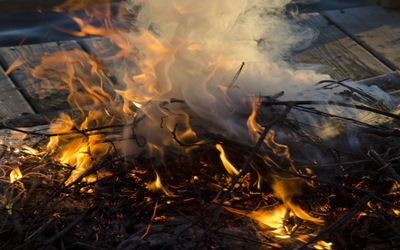As with any by-product of burning, wood smoke contains a number of pollutants that can be harmful to your wellbeing. The four main ones that threaten your health are particulate matter, carbon monoxide (CO), volatile organic compounds (VOCs) and polycyclic aromatic hydrocarbons. Let’s take a look at the potential dangers of each pollutant.
Particulate matter is one of the primary components of smog, and can travel into your lungs where it will cause respiratory and heart problems. At high levels, colourless, odourless CO gas is poisonous, and can mess up your blood’s delivery of oxygen to the rest of your body. VOC is a term that covers a wide range of compounds that often don’t have a colour, taste or smell, but they can directly impact your health as well as contributing to smog. Finally, as polycyclic aromatic hydrocarbons are thought to cause cancer, these compounds are of particular concern. Therefore, if you use a wood stove, fireplace or fire pit in your home or garden, you need to take steps to minimise your risk of health damage.
1. Make sure you use the right wood: The wood should be dry, clean and properly seasoned. This means you need to cut it, split it and stack it in a covered area for about six months before you burn it.
2. Make sure you use the right technique: With the right technique, you can produce more heat and, as a result, use less wood. When you’re starting the fire, allow for as much ventilation and possible. Then, when the wood is well-charred, close the dampers.
3. Make sure you use the right size: As smaller pieces of wood burn more efficiently, they are a better source of heat so opt for smaller sizes.
4. Make sure you don’t burn household waste: It can be tempting to get rid of your household rubbish by just chucking it on the fire, but it can really do some damage to your fireplace or fire pit. More to the point, wrappers, plastics, foam, the coloured ink on magazines, and boxes produce harmful chemicals when burned, so you’re not doing any good to your environmental wellness.
5. Make sure the wood has not been chemically treated: Pressure treated or any other chemically treated wood is often used for structures in outdoor settings such as fences, decks and play structures, but it’s not safe to burn. These kinds of woods produce smoke that may produce chemical residues that could threaten your health. Instead, consult the local authorities in your area for the best way to dispose of chemically treated wood.
6. Make sure the wood you use won’t emit toxins into the environment: Driftwood, plywood, particle board, or any wood with glue on or in it will release toxic chemicals when burned, so steer clear.
7. Make sure the wood doesn’t threaten family wellness: Burning wood that’s wet, rotted, diseased or mouldy may expose your family to health-harming moulds and spores. If your child has a respiratory condition, they will be at a particular risk as these conditions are believed to be especially sensitive to mould. Plus, you can protect yourself and your family from carbon monoxide (CO) poisoning by installing at least one CO detector in your home.
8. Make sure the air is right: You should not burn wood on days when the air pollution levels are high.
9. Make sure you keep up with the maintenance and care guidelines: There’s a reason that the manufacturers recommend certain procedures, so follow these carefully when cleaning and maintaining your chimney.
